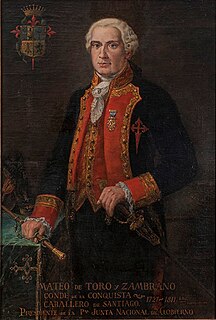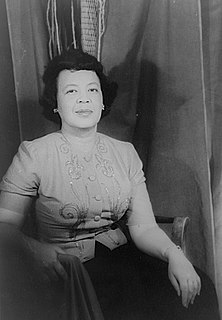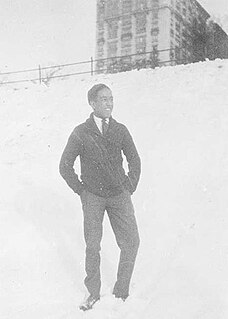
A sonnet is a poetic form that originated in the poetry composed at the Court of the Holy Roman Emperor Frederick II in the Sicilian city of Palermo. The 13th-century poet and notary Giacomo da Lentini is credited with the sonnet's invention, and the Sicilian School of poets who surrounded him then spread the form to the mainland. The earliest sonnets, however, no longer survive in the original Sicilian language, but only after being translated into Tuscan dialect.

Lucila Godoy Alcayaga, known by her pseudonym Gabriela Mistral, was a Chilean poet-diplomat, educator and humanist. In 1945 she became the first Latin American author to receive a Nobel Prize in Literature, "for her lyric poetry which, inspired by powerful emotions, has made her name a symbol of the idealistic aspirations of the entire Latin American world". Some central themes in her poems are nature, betrayal, love, a mother's love, sorrow and recovery, travel, and Latin American identity as formed from a mixture of Native American and European influences. Her portrait also appears on the 5,000 Chilean peso bank note.

Nicolás Cristóbal Guillén Batista was a Cuban poet, journalist, political activist, and writer. He is best remembered as the national poet of Cuba.
The tragic mulatto is a stereotypical fictional character that appeared in American literature during the 19th and 20th centuries, starting in 1837. The "tragic mulatto" is a stereotypical mixed-race person, who is assumed to be depressed, or even suicidal, because they fail to completely fit in the "white world" or the "black world". As such, the "tragic mulatto" is depicted as the victim of the society that is divided by race, where there is no place for one who is neither completely "black" nor "white".

Alfonsina Storni was an Argentine poet and playwright of the modernist period.

Field Marshal Mateo de Toro Zambrano y Ureta, frequently misnamed Mateo de Toro y Zambrano in many Chilean history publications, was Viscount of La Descubierta and later Count of La Conquista (1771) and Knight of the Spanish Order of Santiago. He was a Chilean creole and had a career as a soldier under the Spanish Empire after he amassed a fortune in commerce.

Margaret Allison Bonds was an American composer, pianist, arranger, and teacher. One of the first Black composers and performers to gain recognition in the United States, she is best remembered today for her popular arrangements of African-American spirituals and frequent collaborations with Langston Hughes.

Ricardo Eliécer Neftalí Reyes Basoalto, better known by his pen name and, later, legal name Pablo Neruda, was a Chilean poet-diplomat and politician who won the 1971 Nobel Prize in Literature. Neruda became known as a poet when he was 13 years old, and wrote in a variety of styles, including surrealist poems, historical epics, overtly political manifestos, a prose autobiography, and passionate love poems such as the ones in his collection Twenty Love Poems and a Song of Despair (1924).

Sonnet 144 was published in the Passionate Pilgrim (1599). Shortly before this, Francis Meres referred to Shakespeare's Sonnets in his handbook of Elizabethan poetry, Palladis Tamia, or Wit's Treasurie, published in 1598, which was frequently talked about in the literary centers of London taverns. Shakespeare's sonnets are mostly addressed to a young man, but the chief subject of Sonnet 127 through Sonnet 152 is the "dark lady". Several sonnets portray a conflicted relationship between the speaker, the "dark lady" and the young man. Sonnet 144 is one of the most prominent sonnets to address this conflict.
María Nicolasa de Valdés y de la Carrera was the first First Lady of Chile from September 18, 1810, when her husband became President in Chile's First Government Junta, until her death four months later.

James Mercer Langston Hughes was an American poet, social activist, novelist, playwright, and columnist from Joplin, Missouri. One of the earliest innovators of the literary art form called jazz poetry, Hughes is best known as a leader of the Harlem Renaissance. He famously wrote about the period that "the Negro was in vogue", which was later paraphrased as "when Harlem was in vogue."

Fernando Santiván (1886–1973) was a Chilean writer. He won the Chilean National Prize for Literature in 1952. His real name was Fernando Santibañez Puga.

"The Negro Speaks of Rivers" is a poem by American writer Langston Hughes. Hughes wrote the poem when he was 17 and crossing the Mississippi River on the way to visit his father in Mexico. It was first published the following year in The Crisis, starting Hughes's literary career. "The Negro Speaks of Rivers" uses rivers as a metaphor for Hughes's life and the broader African-American experience. It has been reprinted often and is considered one of Hughes's most famous and signature works.

Paulina García Alfonso, better known as Pali García, is a Chilean actress, stage director, and playwright.

Doris Dana was an American translator known for having been the partner of Gabriela Mistral, the Chilean Nobel Prize winner. Dana inherited Mistral's estate following Mistral's death in January 1957.
Claudia Irene Celedón Ureta is a Chilean television, film, and theater actress. She is the winner of an Altazor Award for best theater actress for her role in the play Mujer gallina, and was awarded at the Cartagena International Film Festival for her role in Old Cats. She is the mother of the actress Andrea García-Huidobro, and ex-wife of Cristián García-Huidobro.

Carolina Mercer Langston was an American writer, actress and mother to poet, playwright and social activist Langston Hughes.

Luis Alfonso Ureta Medina is a Chilean footballer who plays as a goalkeeper for Chilean Primera División side O'Higgins.

The Sweet Flypaper of Life is a 1955 fiction and photography book by American photographer Roy DeCarava and American writer Langston Hughes. DeCarava's photos and Hughes's story, told through the character Sister Mary Bradley, depict and describe Black family life in Harlem, New York City, in the 1950s.

The 1967 Nobel Prize in Literature was awarded to the Guatemalan writer Miguel Ángel Asturias (1899–1974) "for his vivid literary achievement, deep-rooted in the national traits and traditions of Indian peoples of Latin America." He is the first Guatemalan and the second Latin American author to receive the prize after the Chilean poet Gabriela Mistral won in 1945.
















